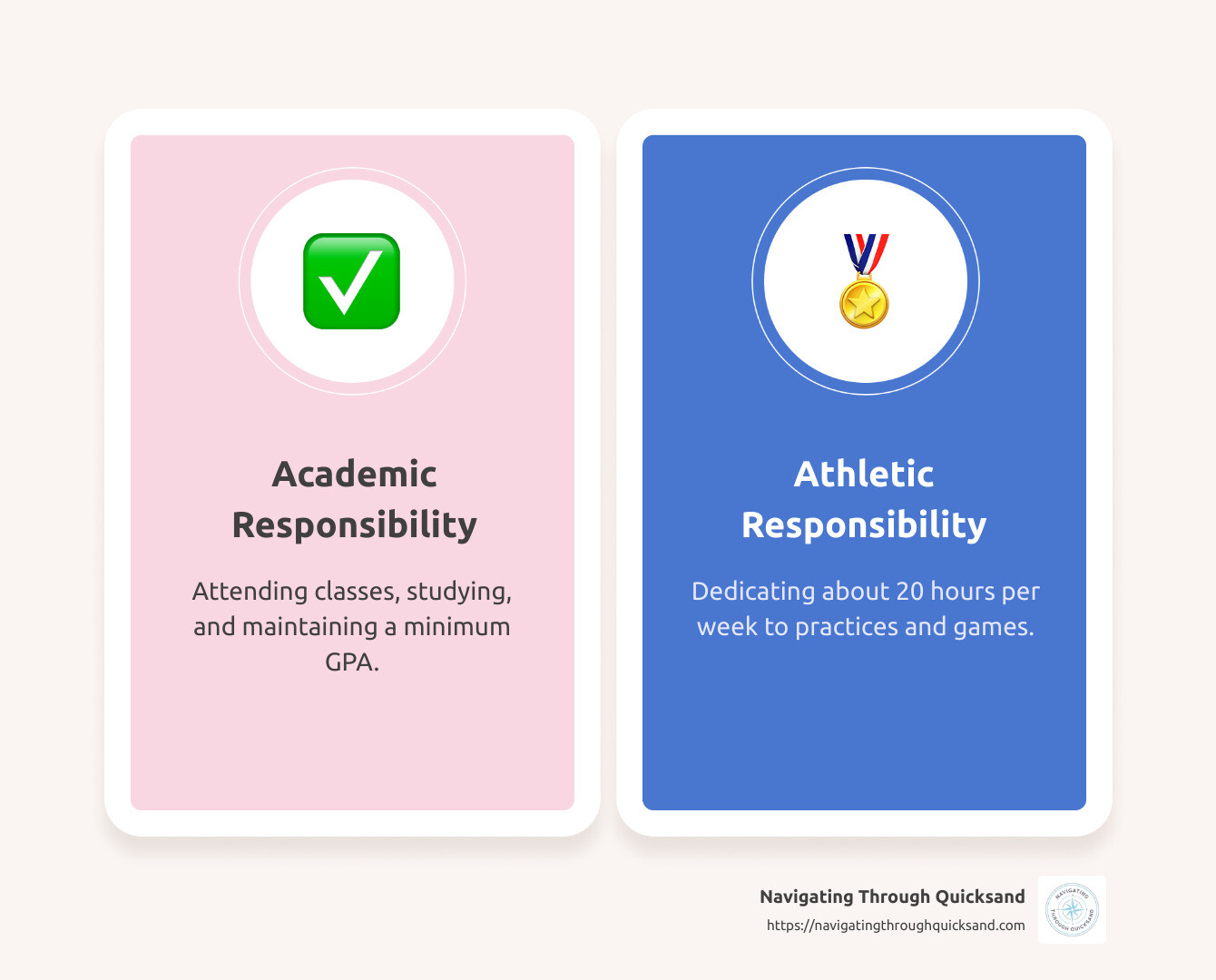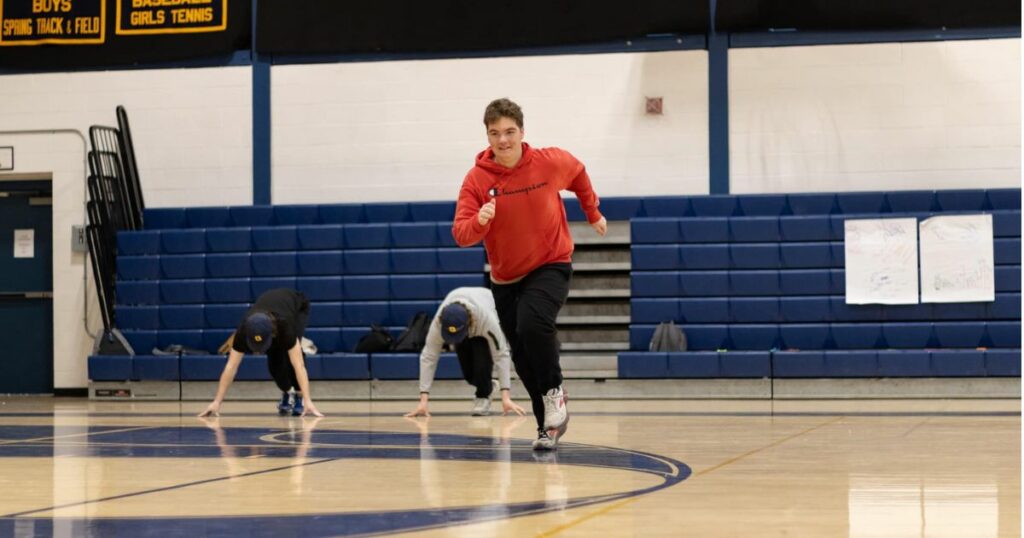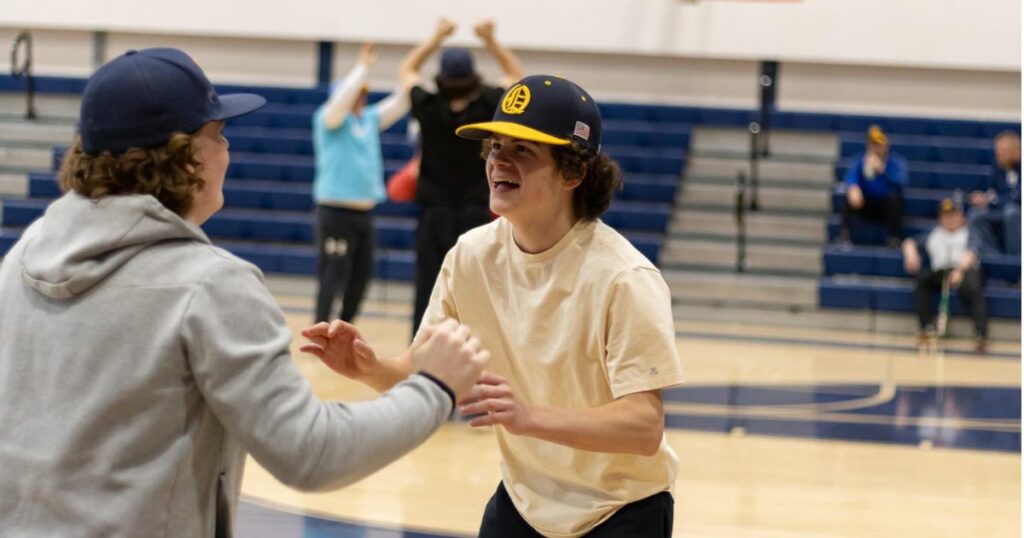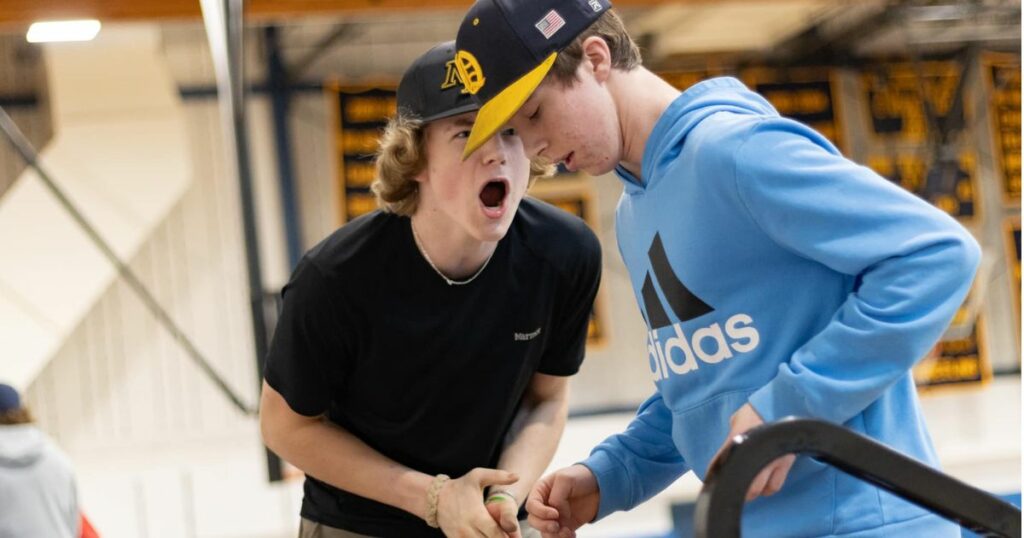What’s a student athlete? A student athlete is both a full-time or part-time student at a university or college and an active participant in an organized and competitive athletic program offered by the school. Athletic scholarships are a form of financial aid offered to student athletes, which can cover expenses such as tuition, books, fees, room, and board.
Here are the basic roles and responsibilities of a student athlete:
- Dual Role: Balancing both academic and athletic commitments.
- Academic Responsibility: Attending classes, studying, and maintaining a minimum GPA.
- Athletic Responsibility: Dedicating about 20 hours per week to practices and games, as per NCAA guidelines, and representing their college in athletic competitions.
- Support from Athletic Programs: Athletic programs provide support such as special tutoring, study sessions, and mentoring to help student-athletes balance their academic and athletic commitments.
- Community Role: Representing the school positively in all aspects.
These individuals must skillfully manage their time to meet both educational and athletic demands, often facing a schedule more rigorous than that of their non-athlete peers. Despite challenges, being a student athlete offers unique opportunities to develop leadership, time management skills, and camaraderie.

Table of Contents
What’s a Student Athlete?
Definition of a Student Athlete
A student athlete, also known as a college athlete, is a person who is enrolled as a full-time or part-time student at a university or college and also participates in organized, competitive sports programs offered by the institution. These athletes compete in various sports, ranging from soccer and basketball to swimming and even unique sports like subaquatic hockey.
Responsibilities of a Student Athlete
Being a student athlete involves a dual role: excelling in academics while also committing to athletic responsibilities. This combination can make their schedules particularly demanding.
Academic Requirements
To maintain their status, student athletes must meet certain academic standards. For example, they need to:
- Attend Classes: Just like any other student, they must attend classes and complete assignments.
- Maintain a Minimum GPA: Organizations like the NCAA require student athletes to maintain a specific GPA to remain eligible for competition.
Athletic Commitments
Athletic responsibilities are equally rigorous. Participating in college sports offers numerous benefits and experiences, such as forming long-lasting friendships and gaining personal, financial, and professional payoffs. The camaraderie and bonding within sports teams are significant, as student-athletes build mutual respect and deeper bonds of friendship through team-building activities, practice, team competitions, and traveling. They often include:
- Practice Hours: According to the NCAA, student athletes typically spend about 20 hours per week in practice sessions.
- Games and Competitions: Participation in regular games and competitions, sometimes requiring travel.
- Training: Additional training sessions, even during off-season periods.
Time Management
Balancing these dual roles requires exceptional time management skills. A typical day might start with early morning conditioning, followed by classes, practice in the afternoon, and then study sessions or homework in the evening. Blair McDonald, a sophomore on the Vanderbilt Women’s Soccer team, describes it as finding an “impossible balance between school, sports, and sleep.”
Governing Bodies: NCAA, NAIA, NJCAA
Various organizations govern college athletics, each with its own set of rules and standards:
- NCAA (National Collegiate Athletic Association): The National Collegiate Athletics Association is one of the primary governing bodies for college athletics, overseeing more than 1,200 schools and 23 sports. It has stringent academic and athletic requirements.
- NAIA (National Association of Intercollegiate Athletics): Manages about 300 schools and 13 sports, with slightly less stringent requirements than the NCAA.
- NJCAA (National Junior College Athletic Association): Focuses on two-year colleges and offers opportunities for student athletes to compete and potentially transfer to four-year institutions.
These organizations also regulate athletic scholarships, which can cover various expenses for student athletes such as tuition, books, fees, room, and board.
These organizations not only regulate athletic scholarships but also ensure that student athletes meet academic and eligibility requirements.
In summary, a student athlete is someone who must juggle the responsibilities of being a student and an athlete, adhering to the guidelines set by governing bodies like the NCAA, NAIA, and NJCAA. This dual role demands exceptional time management, dedication, and resilience.
Benefits of Being a Student Athlete

Developing Interpersonal Skills
Being a student athlete goes beyond just playing sports; it’s a crash course in essential life skills. Leadership is a key skill developed as athletes often take on roles that require guiding their teammates. They also learn teamwork by working together towards common goals, which is crucial not just on the field but in any career.
Time management is another vital skill. Balancing practice, games, and academics forces student athletes to prioritize tasks and manage their time efficiently. This ability to juggle multiple responsibilities makes them highly attractive to future employers.
Forming Long-Lasting Friendships
One of the most rewarding aspects of being a student athlete is the camaraderie and mutual respect built with teammates. These friendships often last a lifetime. Shared experiences like team bonding activities, victories, and even losses create deep connections.
For example, Blair McDonald, a sophomore on the Vanderbilt Women’s Soccer team, shared her experience of forming lifelong friendships through team activities and mutual dedication to the sport. These bonds go beyond the field, creating a support system that helps in both personal and professional life.
Academic Assistance
Colleges understand the challenging dual role of student athletes and offer extensive academic assistance. Many schools provide tutoring and study sessions specifically for athletes. Coaches often arrange for mentoring to help athletes stay on track academically.
At the University of Bridgeport, for instance, there’s a student-athlete advisory committee (SAAC) that provides insights into the student-athlete experience and offers input on academic policies. This ensures that athletes have the support they need to succeed in their studies.
Financial Assistance and Athletic Scholarships
One of the significant benefits of being a student athlete is the financial assistance available through athletic scholarships. Athletic scholarships can cover a substantial portion of tuition, books, fees, room, board, and living costs, making college more affordable. These scholarships can vary in percentage based on the student-athlete’s athletic abilities and achievements. It is important to note that receiving an athletic scholarship is not mandatory to be considered a student-athlete, but it does provide additional opportunities and responsibilities.
Financial aid options extend beyond scholarships. Many schools offer additional merit-based aid and other financial aid options to support student athletes. This financial support can be a game-changer, especially for students from low-income backgrounds, providing them with opportunities they might not have had otherwise.
In summary, the benefits of being a student athlete extend far beyond the field. From developing essential life skills to forming lifelong friendships and receiving academic and financial support, the experience is invaluable.
Challenges Faced by Student Athletes

Balancing Academics and Athletics
Being a student athlete means juggling two demanding roles. Time management becomes crucial as athletes try to meet both academic and athletic commitments.
A typical day for a student athlete often starts early with conditioning sessions, followed by classes, and then practice in the afternoon. As Blair McDonald, a sophomore on the Vanderbilt Women’s Soccer team, shared, “It means ending practice at 6 p.m. just to wake up at 6 a.m. the next morning for early conditioning.” This packed schedule leaves little room for rest or social activities.
Academic pressure is another significant challenge. Many student athletes must maintain a certain GPA to remain eligible for their sport. According to Research in Higher Education, balancing these demands can be overwhelming, especially for those taking multiple AP classes or preparing for college applications.
Physical and Mental Health
Physical health is a constant concern. Injuries are common and can sideline athletes for weeks or even end their careers. As noted in the New England Journal of Medicine, the physical toll on athletes includes sore legs, arms, backs, and even more severe injuries like torn ligaments or concussions.
Mental health is equally important but often overlooked. The pressure to perform well both academically and athletically can lead to stress and anxiety. As Eric Bloom, a Social Studies teacher, pointed out, athletes often demonstrate discipline in their sport but struggle to apply the same focus to their studies. This imbalance can lead to emotional instability.
Support systems are crucial for managing these challenges. Many schools offer tutoring and mentoring programs specifically for student athletes. Coaches and teammates also provide emotional support, helping athletes navigate the ups and downs of their dual roles.
In summary, being a student athlete involves significant challenges, from managing a busy schedule to dealing with physical injuries and mental stress. However, with the right support systems, these challenges can be navigated successfully.
How to Become a Student Athlete
High School Preparation
Becoming a student athlete starts long before you step onto a college campus. Preparation in high school is key for high school athletes, especially in the recruitment process for college sports. Here are the essential steps:
- Academic Performance: Focus on maintaining a strong GPA. The NCAA requires a minimum GPA for eligibility, and higher grades can also open up more scholarship opportunities. Aim to excel in your core courses, as these are crucial for meeting NCAA requirements.
- Athletic Performance: Participate in high school sports and aim to stand out. Compete in local, regional, and national events to get noticed. Consistent performance and improvement are critical.
- Extracurricular Activities: Engage in activities outside of sports. This shows colleges that you are well-rounded and can manage multiple responsibilities. Leadership roles in clubs or community service can be particularly impressive.
Recruitment Process
The recruitment process can be complex, but understanding it makes it easier to navigate and opens up opportunities to play college sports. Here’s a breakdown:
- College Scouting: College scouts often attend high school games and tournaments. Perform well to catch their eye. Keep an updated highlight reel and athletic resume ready to share.
- Recruitment Events: Attend camps, showcases, and recruitment fairs. These events are excellent opportunities to display your skills and meet college coaches.
- Communication with Coaches: Reach out to college coaches via email or social media. Express your interest in their program and share your athletic achievements. Building a relationship with coaches can significantly impact your recruitment.
Eligibility Requirements and NCAA Eligibility Center
Meeting eligibility requirements is crucial to becoming a student athlete. Here’s what you need to know:
- NCAA Requirements: For NCAA Division I and II schools, you must complete 16 core courses in high school. Your GPA in these courses must meet the minimum standard, and you must achieve a qualifying SAT or ACT score.
- NAIA Requirements: The NAIA has similar but slightly less stringent requirements. You need to graduate from high school and meet two out of three criteria: a minimum GPA of 2.0, a minimum SAT score of 860 or ACT score of 16, or be in the top half of your graduating class.
- Standardized Tests: Both the NCAA and NAIA require SAT or ACT scores. Check the specific score requirements for the division you’re aiming for and prepare accordingly.
By following these steps and meeting the necessary requirements, you can increase your chances of becoming a successful student athlete.
Conclusion
Navigating the life of a student-athlete is like mastering a delicate balancing act. It requires juggling academic responsibilities, athletic commitments, and personal well-being—all while striving for excellence in every area.
Navigating Through Quicksand is here to support student-athletes in this challenging journey. We understand the unique pressures they face and offer resources to help them turn adversities into strengths.
Student-athletes often endure long days filled with classes, practice, and study sessions. This demanding schedule can be overwhelming, but it also teaches valuable life skills. Time management, leadership, and resilience are just a few of the qualities that student-athletes develop through their experiences.
Contact us today at Navigating Through Quicksand, we offer workshops, fitness sessions, and one-on-one coaching to help student-athletes thrive. Our programs are designed to enhance their skills, boost their confidence, and foster a positive mindset. We believe that with the right support, student-athletes can overcome any obstacle and achieve their goals.
In conclusion, being a student-athlete is challenging, but the rewards are immense. The lessons learned and the bonds formed will last a lifetime. If you’re a student-athlete looking for guidance, or simply want to learn more about this unique experience, visit our Benefits of Being a Student Athlete page for more information.
By embracing the challenges and turning them into opportunities for growth, student-athletes can navigate through the quicksand of life and emerge stronger, more resilient, and ready to shine.
Frequently Asked Questions about Student Athletes

What defines a student-athlete?
A student-athlete is someone who balances the dual role of being both a student and an athlete. This means they are enrolled in a full-time or part-time academic program at a university or college while also participating in competitive sports organized by the school.
To maintain eligibility, student-athletes must meet specific academic and athletic responsibilities. They must:
- Attend classes and complete assignments
- Maintain a minimum GPA
- Participate in regular practices and competitions
The National Collegiate Athletic Association (NCAA) and the National Association of Intercollegiate Athletics (NAIA) set specific guidelines and requirements for student-athletes, including academic standards and athletic commitments.
Is it hard to be a student-athlete?
Yes, being a student-athlete is challenging. Balancing academics and athletics requires excellent time management and discipline. Here’s why:
- Busy Schedules: Student-athletes often have packed schedules. They attend classes during the day and go to practices and games in the evenings and weekends. This leaves little time for rest or social activities.
- Academic Pressure: They must maintain a certain GPA to stay eligible for their sport. This means they need to manage their study time effectively, often squeezing in homework between practices or during travel.
- Physical and Mental Demands: The physical demands of regular training and competitions can lead to fatigue and injuries. Additionally, the mental pressure to perform well both academically and athletically can be overwhelming.
Blair McDonald, a sophomore on the Vanderbilt Women’s Soccer team, shares her experience:
“It means finding an impossible balance between school, sports, and sleep (notice I didn’t say anything about a social life). It means sore legs, arms, backs, knees, ankles, necks…even hair? It means 15-minute naps between class and practice.”
Prospective student athletes interested in college soccer and receiving athletic scholarships should focus on academic eligibility and time management skills, balancing athletic competitions with attending classes and team meetings to ensure a fulfilling student athlete experience. Attending practice and maintaining interpersonal skills are crucial for remaining eligible while navigating busy schedules and pursuing educational institutions that offer full ride scholarships and support for playing sports at the collegiate level.
What do student-athletes call non-athletes?
Student-athletes often have their own lingo to refer to non-athletes. Some common terms include:
- Muggles: Borrowed from the “Harry Potter” series, this term humorously refers to those who don’t participate in sports.
- Normies: This term is used to describe students who lead a more typical college life without the added pressures of athletics.
- Narps: An acronym for “Non-Athletic Regular Person,” this term highlights the difference between the lifestyle of student-athletes and their peers.
These terms are often used lightheartedly and reflect the unique culture and camaraderie within athletic communities.
By understanding these aspects, you can see that being a student-athlete involves a complex balance of responsibilities, requiring dedication and resilience. This dual role shapes their college experience in unique ways, offering both challenges and rewards.
Our Content
Our content is carefully created and edited by Ashley Gustafson to ensure that the content is accurate, reliable, and up-to-date. Navigating Through Quicksand, LLC is a trusted inspirational woman, inspirational speaker, and personal development coach in Massachusetts for confidence coaching programs for women such as leadership workshops, communication workshops, low self-confidence programs, and more. Navigating Through Quicksand, LLC has empowered individuals with over 15 years of experience working with students and athletic teams from local communities.



